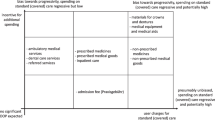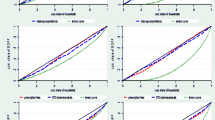Abstract
The studies on the demand for healthcare in low- and middle-income countries rarely take into consideration the fact that many people spend their income on self-treatment and professional treatment. The estimation of the income elasticity of demand for self-treatment and professional treatment can show a more precise picture of the affordability of professional care. This paper contributes to the discussion around estimates of income elasticity of health spending and discussion whether professional care and self-treatment are close to a luxury good and inferior good respectively in a middle-income country. We apply the switching regression model to explain the choice between self-treatment and professional healthcare via estimates of the income elasticity. Estimates are made with the use of the Russian Longitudinal Monitoring Survey — Higher School of Economics (RLMS-HSE), a nationally representative survey. While individual expenditure on professional treatment is higher than that on self-treatment, our estimates show that expenses on professional treatment can be income inelastic except when spending on medicines prescribed by a physician that are elastic. The results also indicate that cost of self-treatment is income elastic. In all cases, the considered income elasticities are statistically insignificant between professional and self-treatment.





Similar content being viewed by others
Data Availability
The «Russia Longitudinal Monitoring Survey, RLMS-HSE» (RLMS-HSE), conducted by the National Research University « Higher School of Economics» and OOO «Demoscope» together with Carolina Population Center, the University of North Carolina at Chapel Hill and the Institute of Sociology the Russian Academy of Sciences. RLMS-HSE is available on the web-site: http://www.cpc.unc.edu/projects/rlms-hse.
Notes
There is no hard and fast way to measure the self-treatment phenomenon at the country level and different questionnaires show different results. Because of this these numbers cannot be compared with one another and serve a purpose to illustrate how popular self-treatment is.
There are some exceptions when the universal health coverage can reimburse spending on medication, see (Popovich et al., 2011) ‘Healthcare system in Russia’ paragraph for details.
The “Russia Longitudinal Monitoring Survey, RLMS-HSE” (RLMS-HSE), conducted by the National Research University «Higher School of Economics» and OOO «Demoscope» together with Carolina Population Center, the University of North Carolina at Chapel Hill and the Institute of Sociology the Russian Academy of Sciences; RLMS-HSE web sites: http://www.cpc.unc.edu/projects/rlms-hse.
The first question was, “Have you had any health problems in the last 30 days?” If respondent answered “No”, he was asked, “Perhaps in the last 30 days you did not feel well, for example, had a headache, sore throat, or toothache, or had a cold or upset stomach, a slightly elevated temperature, or a burn, injury, or scratch?”
We use ‘home treatment’ instead of ‘self-treatment’ in order to be consistent with the original phrasing in the questionnaire; in the remaining part of this article we use self-treatment to avoid confusion.
We use the lagged value of income to reduce its endogeneity concerned with health problems observed in the period t.
with a few exemptions, see (Popovich et al., 2011) for details.
References
Alavi, N. M., Alami, L., Taefi, S., & Gharabagh, G. S. (2011). Factor analysis of self-treatment in diabetes mellitus: A cross-sectional study. Bmc Public Health, 11(1), 761.
Aarva, P., Ilchenko, I., Gorobets, P., & Rogacheva, A. (2009). Formal and informal payments in health care facilities in two russian cities, Tyumen and Lipetsk. Health Policy and Planning, 24(5), 395–405.
Balabanova, D., Roberts, B., Richardson, E., Haerpfer, C., & McKee, M. (2012). Health Care Reform in the former S oviet U nion: Beyond the transition. Health Services Research, 47(2), 840–864.
Balbuena, F. R., Aranda, A. B., & Figueras, A. (2009). Self-medication in older urban mexicans. Drugs & Aging, 26(1), 51–60.
Belkina, T., Duvanova, N., Karbovskaja, J., Tebbens, J. D., & Vlcek, J. (2017). Antibiotic use practices of pharmacy staff: A cross-sectional study in Saint Petersburg, the Russian Federation. BMC Pharmacology and Toxicology, 18(1), 1–6.
Chang, F., & Trivedi, P. (2003). Economics of self-medication: Theory and evidence. Health Economics, 12(9), 721–739.
Culyer, A. J. (1989). The normative economics of health care finance and provision. Oxford Review of Economic Policy, 5(1), 34–58.
Di Matteo, L. (2003). The income elasticity of health care spending. The European Journal of Health Economics, 4(1), 20–29.
Feeley, F. G., Sheiman, I. M., & Shishkin, S. V. (1999). Health sector informal payments in Russia. Private Practice, 3(4), 15.
Gerry, C. J., Kaneva, M., & Zasimova, L. (2017). Reforming voluntary drug insurance in russian healthcare: Does social solidarity matter? Health Policy, 121(11), 1177–1185.
Hjortsberg, C. (2003). Why do the sick not utilise health care? The case of Zambia. Health Economics, 12(9), 755–770.
Kumar, N., Kanchan, T., Unnikrishnan, B., Rekha, T., Mithra, P., Kulkarni, V., Papanna, M. K., Holla, R., & Uppal, S. (2013). Perceptions and practices of self-medication among medical students in coastal South India.PloS One, 8(8).
Lam, C. L., Catarivas, M. G., Munro, C., & Lauder, I. J. (1994). Self-medication among Hong Kong Chinese. Social Science & Medicine, 39(12), 1641–1647.
Lei, X., Jiang, H., Liu, C., Ferrier, A., & Mugavin, J. (2018). Self-medication practice and associated factors among residents in Wuhan, China. International Journal of Environmental Research and Public Health, 15(1), 68.
Lacroix, G., & Radtchenko, N. (2011). The changing intra-household resource allocation in Russia. Journal of Population Economics, 24(1), 85–106.
Lépine, A. (2015). Is Health a necessity in Sub-Saharan Africa? An investigation of income‐elasticity of Health Expenditures in Rural Senegal. Journal of International Development, 27(7), 1153–1177.
Lokshin, M., & Sajaia, Z. (2004). Maximum likelihood estimation of endogenous switching regression models. The Stata Journal, 4(3), 282–289.
Novokmet, F., Piketty, T., & Zucman, G. (2018). From soviets to oligarchs: Inequality and property in Russia 1905–2016. The Journal of Economic Inequality, 16(2), 189–223.
Ocan, M., Obuku, E. A., Bwanga, F., Akena, D., Richard, S., Ogwal-Okeng, J., & Obua, C. (2015). Household antimicrobial self-medication: A systematic review and meta-analysis of the burden, risk factors and outcomes in develo** countries. Bmc Public Health, 15(1), 742.
Okumura, J., Wakai, S., & Umenai, T. (2002). Drug utilisation and self-medication in rural communities in Vietnam. Social Science & Medicine, 54(12), 1875–1886.
Pagan, J. A., Ross, S., Yau, J., & Polsky, D. (2006). Self-medication and health insurance coverage in Mexico. Health Policy, 75(2), 170–177.
Parker, S., & Wong, R. (1997). Household income and health care expenditures in Mexico. Health Policy, 40(3), 237–255.
Popovich, L., Potapchik, E., Shishkin, S., Richardson, E., Vacroux, A., & Mathivet, B. (2011). & World Health Organization. Russian Federation: Health system review.
Radchenko, N. (2016). Welfare sharing within households: Identification from subjective well-being data and the collective model of labor supply. Journal of Family and Economic Issues, 37(2), 254–271.
Rous, J. J., & Hotchkiss, D. R. (2003). Estimation of the determinants of household health care expenditures in Nepal with controls for endogenous illness and provider choice. Health Economics, 12(6), 431–451.
Shafie, M., Eyasu, M., Muzeyin, K., Worku, Y., & Martin-Aragon, S. (2018). Prevalence and determinants of self-medication practice among selected households in Addis Ababa community.PloS One, 13(3).
Sheiman, I., Shishkin, S., & Shevsky, V. (2018). The evolving Semashko model of primary health care: The case of the Russian Federation. Risk Management and Healthcare Policy, 11, 209.
Shishkin, S., Potapchik, E., & Selezneva, E. (2014). Out-of-pocket payments in the post-Semashko health care system. Higher School of Economics Research Paper No. WP BRP, 14.
Stratchounski, L. S., Andreeva, I. V., Ratchina, S. A., Galkin, D. V., Petrotchenkova, N. A., Demin, A. A., Kuzin, V. B., Kusnetsova, S. T., Likhatcheva, R. Y., & Nedogoda, S. V. (2003). The inventory of antibiotics in russian home medicine cabinets. Clinical Infectious Diseases, 37(4), 498–505.
Suleman, S., Ketsela, A., & Mekonnen, Z. (2009). Assessment of self-medication practices in Assendabo town, Jimma zone, southwestern Ethiopia. Research in Social and Administrative Pharmacy, 5(1), 76–81.
Tandon, A., Murray, C. J., Lauer, J. A., & Evans, D. B. (2000). Measuring overall health system performance for 191 countries. Geneva: World Health Organization.
Tulchinsky, T. H., & Varavikova, E. A. (1996). Addressing the epidemiologic transition in the former Soviet Union: Strategies for health system and public health reform in Russia. American Journal of Public Health, 86(3), 313–320.
Yuefeng, L., Keqin, R., & **aowei, R. (2012). Use of and factors associated with self-treatment in China. Bmc Public Health, 12(1), 995.
Wang, R., Ma, C., Jiang, K., Li, M., & Ma, S. (2018). Descriptions of self-treatment for the middle-aged and elderly in Shanxi, China.PloS One, 13(6).
Zare, H., Trujillo, A. J., Leidman, E., & Buttorff, C. (2013). Income elasticity of health expenditures in Iran. Health Policy and Planning, 28(6), 665–679.
Zasimova, L. (2016). The use of medical care and out-of-pocket payments in Russia. Scandinavian Journal of Public Health, 44(5), 440–445.
Zhao, Y., & Ma, S. (2016). Observations on the prevalence, characteristics, and effects of self-treatment. Frontiers in Public Health, 4, 69.
Funding
This research was supported by a Russian Science Foundation grant, project No. 20-18-00307, “Health of Nation: A Multidimensional Analysis of Health, Health Inequality and Health-Related Quality of Life”.
Author information
Authors and Affiliations
Contributions
Andrey Aistov prepared the dataset and estimated the models; Ekateria Aleksandrova and Eugene Zazdravnykh together wrote the text of this manuscript. Ekateria Aleksandrova mainly contributed to the Discussion and Conclusions part and Introduction, the other paragraphs mainly written by Eugene Zazdravnykh.
Corresponding author
Additional information
Publisher’s Note
Springer Nature remains neutral with regard to jurisdictional claims in published maps and institutional affiliations.
z,2 Eugene Zazdravnykh, HSE University; Graduate School of Management, St. Petersburg University, Saint Petersburg, Russia; E-mail: ezazdravnykh@hse.ru;
y,3 Andrey Aistov, HSE University, Niznhy Novgorod, Russia; E-mail: aaistov@hse.ru;
x,4 Ekaterina Aleksandrova, Sechenov University, Moscow, Russia; E-mail: aleksandrova_e_a_1@staff.sechenov.ru.
Rights and permissions
Springer Nature or its licensor (e.g. a society or other partner) holds exclusive rights to this article under a publishing agreement with the author(s) or other rightsholder(s); author self-archiving of the accepted manuscript version of this article is solely governed by the terms of such publishing agreement and applicable law.
About this article
Cite this article
Zazdravnykh, E., Aistov, A. & Aleksandrova, E. Total expenditure elasticity of spending on self-treatment and professional healthcare: a case of Russia. Int J Health Econ Manag. 24, 81–105 (2024). https://doi.org/10.1007/s10754-023-09353-0
Received:
Accepted:
Published:
Issue Date:
DOI: https://doi.org/10.1007/s10754-023-09353-0




